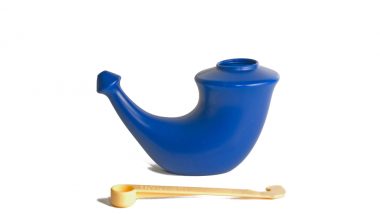A 69-year-old US woman died after she contracted a brain infection from using tap water in a neti pot. The Seattle woman was advised to use nasal irrigation to treat a chronic case of sinusitis. Her case is presented in the September issue of the International Journal of Infectious Disease. Doctors believe she could have contracted the infection from a water-borne amoeba, which made its way into her brain through the sinus cavity.
The woman was a breast cancer survivor in the distant past and was undergoing treatment for chronic sinusitis. She was advised saline irrigation to clear the mucus in her nasal passages where the drugs failed to give her any relief. But instead of using sterilised water, the woman used water filtered by Brita Water Purifier.
Since the sinus cavity is a mucous membrane and is at close proximity to the brain, it's hazardous to use plain tap water in the neti pot. Doctors recommended sterilised water or saline to flush out the nasal passages. Man Dies After He Inhales Deadly Brain-Eating Amoeba at a Water Park.
She continued using tap water in the neti pot for over a month, after which she started developing a rosacea-like rash on the bridge of her nose. Multiple trips to the dermatologists, three skin biopsies and treatment with mupirocin ointment later, her skin condition didn't abate one bit. Australian Man Eats a Slug On a Dare From Friends, Dies 8 Years Later Due To Rat Lung Disease.
A year after she developed the rash, the patient suffered a seizure and shaking on the left side of her body. CT scan revealed that there was a 1.5 cm lesion on the brain, which the doctors mistook for a tumour seen in patients with a history of breast cancer.
A sliver of the tumour was sent to the John Hopkins University for analysis. There the neuropathologists were able to identify the mass as a result of an infection caused by the amoeba Balamuthia mandrillaris. Her condition started deteriorating and was sent for another surgery. But despite treatment with strong anti-amoebic drugs, the woman slipped into a coma and subsequently died.
Balamuthia mandrillaris is a free-living amoeba, found in soil and water. The pathogen can affect the brain and the spinal cord, causing an infection called Granulomatous Amebic Encephalitis.
What's a Neti Pot?
A neti pot is a small container with a kettle-like spout. The pot is usually filled with sterilised or saline water. In diseases like sinusitis where the sinus cavity gets inflamed, doctors recommend nasal irrigation with the neti pot. The container is filled with the liquid and its spout is inserted into one of the person's nostril.
The water then passes through the sinus cavity, flushing out the debris through the other nostril.
To use the neti pot, one has to stand by a sink and tilt the head sideways. Insert the nostril that faces upwards and breathe through your open mouth. Pour the solution, little by little into your upper nostril till the liquid starts flowing out of the lower one.
Passing saline water through the nasal passages helps clear the congestion and pain to a large extent.
Although Jal neti has been a part of Ayurvedic treatment methods for centuries, scientific evidence suggests that nasal irrigation can benefit people who have chronic sinusitis.
If you want to make your own saline solution, the Mayo Clinic recommends that you use bottled water which is distilled or sterilised. Tap water is acceptable only if it has been passed through a filter with a pore size of 1 micron or smaller, or boiled for several hours and cooled to a lukewarm temperature.
(The above story first appeared on LatestLY on Dec 07, 2018 01:07 PM IST. For more news and updates on politics, world, sports, entertainment and lifestyle, log on to our website latestly.com).













 Quickly
Quickly



















